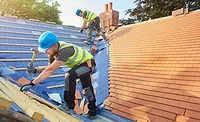Roofing Safety
OSHA's 5 Major Safety Concerns for 2023
Roofing industry experts highlight what OSHA inspectors will be looking for this season.

Choose fall protection systems that address the most common causes of falls, offer sufficient energy absorption, can be top-fixed and retrofitted, and are tested on representative roof types.
It didn’t take the Biden administration very long to demonstrate how it would enforce federal regulations when it came to safety in the workplace. Within days of the 2021 inauguration, the White House directed the Occupational Safety Health Administration (OSHA) to double the number of compliance safety and health officers and step up safety audits nationwide.
Initially delayed into getting into the field by COVID-19 health and safety concerns, now those inspectors are hired on and trained up. Roofing contractors should expect to see their fair share of them at jobsites during this year’s approaching peak season, according to a host of industry experts that RC recently caught up with. Here’s what they said this eager group of safety professionals are focusing on this year.
Increased Fines, Penalties
While there are a lot of aspects to safety that roofing contractors have to worry about on a jobsite, fall protection is still the biggest. With 5,260 citations, it topped OSHA’s top ten most-frequently cited workplace safety standards again in 2022 – its 12th straight year at the top.
So, fall protection is nothing new to roofers, but the some of ways OSHA will enforce them are. Earlier this year, office directors were given authority to issue “instance-by-instance citations” for cases identified as “high-gravity” serious violations of OSHA standards. Federal authorities increased the fines associated with violations to meet inflation.
RC Legal Insights expert Trent Contey, partner with Adams and Reese, said in a brief videochat with RC that roofing contractors should expect to face more costly cumulative citations in the future. “They are piling on these citations if you fall in those categories," he said.
Ladder Liability
Using a ladder is about as basic as it gets for roofing contractors. But that doesn’t mean using them comes without risk. Ladders were involved in more than 160 on-the-job deaths in 2020, according to the U.S. Bureau of Labor Statistics. Another 22,710 workplace injuries were recorded that same year.
Tammy Clark, an OSHA-trained safety consultant shares how contractors can avoid accidents and costly citations related to ladder safety from the moment of set-up to when the job is complete.
“OSHA is really good at spotting from a distance the proper ladder angle, and if there are questions they’re going to pull the tape on it,” she said referring to how inspectors measure ladder angle safety. “It has to be something we talk about frequently because (roofing contractors work on imminent-danger type of projects.”
Beat the Heat
One of the first areas OSHA advisors and leaders targeted upon coming into office was heat-related injuries. Starting in late 2021, the organization reassess key rulemaking factors like heat-stress thresholds, heat-acclimatization planning, and heat-exposure monitoring.
Last April, the agency launched its first-ever national campaign to emphasize the potential danger and preventability of heat-related illnesses. From what to consume on the jobsite, to how many bathroom breaks worker should to take, the safety managers at Western Specialty Contractors offer several tips to protect roofers in the heat.
Distracted Driving
While not just an enforcement issue for agencies like OSHA, distracted driving is a problem in all construction trades. The National Highway Traffic Safety Administration found distracted driving claimed more than 3,100 lives in 2020, and 12% were cellphone related. Commercial drivers are 23 times more like to cause a crash when texting and driving, and 6 times more likely when dialing a phone.
With the number of distracted drivers continuing to rise, the issue is becoming more prevalent for contractors that have to deal with fleet operations, insurance and other pressures.
Avoiding Appeals
Under federal law, employers of any size are able to contest an OSHA violation in writing within 15 days of the citation. If uncontested, the citation and any associated penalties become a final order after that time period.
Long-time employment law attorney and RC contributor Richard Alaniz said each employer may – and should – request an informal conference with the OSHA area director. “It is not uncommon for proposed monetary penalties to be reduced as the result of such a conference,” Alaniz wrote earlier this month. “However, such conferences do not extend the 15-day appeal deadline.”
Looking for a reprint of this article?
From high-res PDFs to custom plaques, order your copy today!







